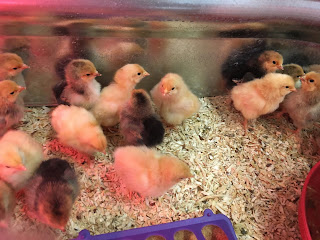Appearance
 |
| Blue Ameraucana rooster |
Ameraucanas have a very distinct appearance. They always have muffs and beards which should nearly cover their face completely. They come in the colors of black, blue, wheaten, blue wheaten, brown red, buff, silver, and white, according to the APA recognized standard. The lavender Ameraucana is becoming popular among enthusiasts, but has yet to be admitted to the Standard of Perfection. Body shape is full, but still slender. Due to the beard, the wattles are very small or absent. The Ameraucana has a pea comb, slate-colored legs, and is clean-legged, meaning there are no feathers on the shanks and toes. Males weight around 6.5lbs, females 5.5lbs.
 |
| Lavender Ameraucana hen |
A Brief History
Ameraucanas descend from the Araucana chicken, which they are often confused with. They have been around for many years, bred from the Araucana chicken by those who wanted a blue laying bird with beards, muffs, and tails. They were first considered a variety of Araucana, before being admitted to the APA in 1976 as a specific breed. This led to confusion, as many breeders of muffed "Araucanas" continued to show their birds as such, sometimes as "American Araucana". In response, the APA began further development of the breed standard of the Ameraucana, thus becoming the breed we know of today.
Since its introduction, this breed has been sought after for it's blue eggs, a rarity among chickens. This trait is shared with only a few other breeds, and is desired due to the beauty and novelty of the color.
 |
| (To the left) A blue chicken egg |
Breed Confusion
Due to mislabeling by hatcheries, Ameraucanas are often mixed up with the common blue-green laying hybrid, the Easter Egger or Easter Egg chicken. Hatcheries often label Easter Eggers as "Americana" to mislead people and make their chicks sound more appealing. The problem is that people buy these birds and breed them without knowing what they have, selling them as "Americanas" just like the hatcheries. Ameraucanas breed true - their leg color, muffs, comb type, egg color, and all other distinguishing features. Easter Eggers do not breed true, and further generations of EEs will show brown eggs, any color legs, clean-faces, weird colors and patterns, and single combs. Due to the same mislabeling, Ameraucanas and EEs are often confused with the Araucana as well, which is a very rare tailless breed with ear tufts, but no beard or muffs. Chicks that are $2.99 at feed stores are Easter Eggers, as Ameraucana chicks generally cost more than $15 per chick!
 |
| A pair of Easter Egger chickens - note the green legs and non-standard coloring |
 |
| Silver Ameraucana hen |
Availability and Where to Buy
Due to the rarity of the Ameraucana, they are not as readily available as common farm chickens. There are only a handful of hatcheries which carry true Ameraucanas. Of these hatcheries is Meyer Hatchery in Ohio, but they are extremely limited and one of their most expensive birds. Your best bet is a local breeder, but this breed is costly. Birds from show-quality parents can cost you upwards of $35 a chick! Some breeders are willing to ship eggs or chicks, but make sure to do your research on the breeder before buying online. Also assure that you understand the breed standard so you can tell if someone is selling actual Ameraucanas or Easter Eggers. If you're willing to pay the price, they lay beautiful blue eggs that many people are willing to pay more for than typical white or brown eggs!
Do you own or breed Ameraucanas? Do you want them? Leave a comment! Remember to check out our Facebook page and Instagram for regular updates!
Sources
American Poultry Associasion. "APA Recognized Breeds and Varieties." APA Recognized Breeds and Varieties (2012): n. pag.Http://www.amerpoultryassn.com/. 1 Jan. 2012. Web. 31 Mar. 2016.
Orr, Richard A. "ABC Breed History." ABC Breed History. Ameraucana Breeder's Club, 1998. Web. 31 Mar. 2016. <http://www.ameraucana.org/history.html>.
"Ameraucana Breed Standard." Ameraucana Breeders Club. American Poultry Assn., 1998. Web. 31 Mar. 2016. <http://www.ameraucana.org/standard.html>.
All images in the article were obtained via Creative Commons and are licensed for noncommercial use.





























